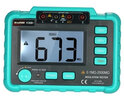Hi All,
Ive been having a bit of an issue with my extensions electrics, for info the extension was built before I moved in, I reckon it was built around 2000.
The issues I've been having is that there is a phantom voltage on the Earth of 120v on the sockets and 70v on the lights. Ive also noticed that a cheap socket tester shows a live earth/ missing ground which started me on my investigation. I checked all the sockets and traced it to the socket behind the fridge, I reckon this is what is causing my issues as the earth cable doesn't have sheathing and is hard up against the live cable and looks to have sliced into it slightly.
My intention is to replace the 1.5m cable from the previous socket and the socket (its proper old) and hopeful this might sort the live earth / phantom voltage.
What i was also thinking is I thought that any spurs off the ring main with more than one socket had to be fused? In my case this spur has; two double sockets, the lighting (which is fused) and an outdoor socket. What I don't know is if the extension builder extended the ringmain, which I doubt as I can't find any other evidence. So I'm thinking that when I replace the socket, if I don't wire the extension supply back in temporarily (safely terminated) before I turn the power back on if the extension is live then the system is acting as 2 radials and therefore the extension builder has extended the ring main and if it is dead then its an extended spur without a fuse. Does this sound right.
The extension has a beefy old plasma tv and a tumble dryer it so I'm just making sure its safe.
Sorry for the long post and no doubt wrong use of terminology, thanks in advance.
Ive been having a bit of an issue with my extensions electrics, for info the extension was built before I moved in, I reckon it was built around 2000.
The issues I've been having is that there is a phantom voltage on the Earth of 120v on the sockets and 70v on the lights. Ive also noticed that a cheap socket tester shows a live earth/ missing ground which started me on my investigation. I checked all the sockets and traced it to the socket behind the fridge, I reckon this is what is causing my issues as the earth cable doesn't have sheathing and is hard up against the live cable and looks to have sliced into it slightly.
My intention is to replace the 1.5m cable from the previous socket and the socket (its proper old) and hopeful this might sort the live earth / phantom voltage.
What i was also thinking is I thought that any spurs off the ring main with more than one socket had to be fused? In my case this spur has; two double sockets, the lighting (which is fused) and an outdoor socket. What I don't know is if the extension builder extended the ringmain, which I doubt as I can't find any other evidence. So I'm thinking that when I replace the socket, if I don't wire the extension supply back in temporarily (safely terminated) before I turn the power back on if the extension is live then the system is acting as 2 radials and therefore the extension builder has extended the ring main and if it is dead then its an extended spur without a fuse. Does this sound right.
The extension has a beefy old plasma tv and a tumble dryer it so I'm just making sure its safe.
Sorry for the long post and no doubt wrong use of terminology, thanks in advance.




